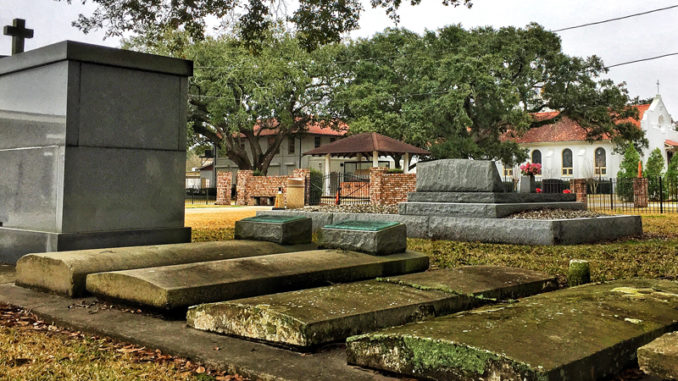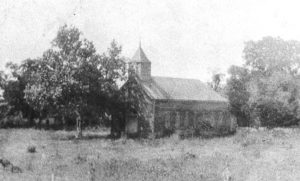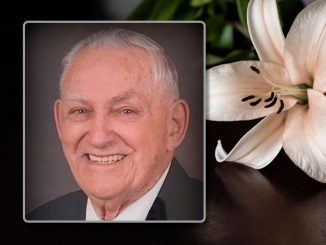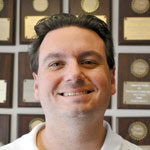
St. Charles Borromeo celebrates 300 years
When the St. Charles Borromeo cemetery was established in Destrehan 300 years ago, in 1718, it set the foundation for what has been one of St. Charles Parish’s greatest cornerstones of tradition.
Not long after the cemetery was built, the St. Charles Borromeo Church was founded. Its church parish has thrived for nearly three centuries since.
“It’s a testament to the community,” said Ronald Rodrigue, St. Charles Borromeo administrative assistant. “There are so many people who are so close.”
The church has come a long way since its humble beginnings: the original church was a log cabin originally residing on the parish’s West Bank, founded by missionary priests in present-day Taft. The original name of the West Bank chapel was La Paroisse de St. Jean des Allemands, or “The Parish of St. John, of the Germans.”
As the population on the East Bank grew, the church relocated there in 1740, building another log cabin and officially renaming the parish and chapel in honor of St. Charles Borromeo. It stood until 1806 and was replaced by a small frame house that became affectionately known as the Little Red Church.
The Little Red Church was St. Charles Borromeo’s home base until the Spanish Colonial-style church that stands in Destrehan today was built in order to address the needs of a larger congregation. A replica of the Little Red Church stands next to that larger church today.
While the St. Charles Borromeo p arishioners endured throughout the 1800s, what’s not clear is if the Little Red Church building that was utilized starting in 1806 was the first to follow the East Bank log cabin. A fire destroyed the church rectory in 1877, costing the church 100 years worth of records.
arishioners endured throughout the 1800s, what’s not clear is if the Little Red Church building that was utilized starting in 1806 was the first to follow the East Bank log cabin. A fire destroyed the church rectory in 1877, costing the church 100 years worth of records.
“We can never get that back,” Rodrigue said. “There were no copies, it’s simply lost forever … That could have been one of two churches.”
The Little Red Church was torn down in 1923, giving way to the structure of today, which was finished construction and officially dedicated in 1922. It was established, Rodrigue notes, on a large portion of land donated to the church parish by the Spanish Petroleum company. One of the church’s first pastors, Father John Francis Basty, eventually started filling out large pieces of that property in order to build the church and a number of school buildings — St. Charles Borromeo school was founded in 1929, the first parochial school opened between New Orleans and Baton Rouge.
The church itself was built utilizing Spanish-style architecture, but most of its parishioners had German roots. The style of the church was intended to honor the Spanish Petroleum company for its land donation, which spanned 100 acres.
“They were very hardworking, religious people,” Rodrigue said of the parishioners. “It started as a German community and it evolved into the German Coast.”
No matter where the church has been or what form its building took, its parish has thrived.
Rodrigue attributes that to a few things, including the fact that St. Charles Parish has held its population, and strong family traditions continued by St. Charles Borromeo Church members.
The cemetery, he says, is greatly representative of the latter point.
“It’s kind of a negative thought, but people die, and no matter where they move, the family always comes back here so they may be buried,” Rodrigue said. “It’s always home. It kind of ties everything together.”
Families have attended the church for generations, and it’s helped to create an incredibly tight-knit community.
“I think you see a great combination between the spiritual and civil community,” Rodrigue said. “The civil parish keeps developing in other areas, helping the population. Maybe the next generation buys their grandparents’ house and renovates it … we see a lot of that.
“We’ve been fortunate that most people stay here in the parish. They still like to call this home.”
The closeness of the St. Charles Borromeo community is what Rodrigue is most proud of.
“This community is one big family,” said Rodrigue, a Destrehan resident and lifelong St. Charles Parish native. “You can always see it at a mass. If you’re a Catholic at a mass, typically you’ll offer the sign of peace to the people next to you, shake their hands … (at St. Charles Borromeo) everyone is waving to everyone across the church. There are so many people who are so close and it’s a testament to the relationships between those in our community.”





Be the first to comment